-
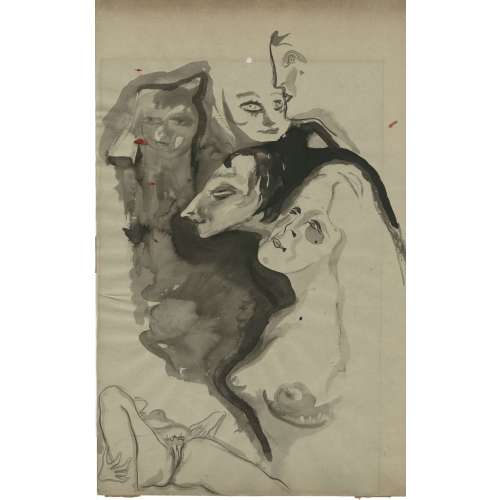 NEW"The Jewish Hungarian artist Nicolas Sternberg moved to Paris in the 1920s, remaining there for the rest of his life, hiding during the German occupation of the city in the 1940s under false identity papers". [MIA: Minneapolis Institute of Art, cited] Jean-Pierre Dutel provides the following information: Nicolas Sternberg was born to Jewish parents on July 9, 1902, in Nagyvárad, in Austro-Hungary. According to the archives of the Préfecture de police in Paris (1930), he was Hungarian. His real name was Miklós Szines-Sternberg. At the time, it was common among painters and sculptors to retain their original German names while adopting Hungarian-German double surnames. From age twelve, he worked as a newspaper illustrator in Budapest before moving to Paris in the early 1920s after studying in Munich. He published regularly in Paris-Soir, one of the most important French daily newspapers between the wars. Despite his talent, only one solo exhibition seems to have been dedicated to him at the Galerie Georges Petit (Georges Petit, 1856–1920) in 1929. Jules Pascin (1885 –1930) exhibited there in 1930 and committed suicide on the opening day. Sternberg is known for his drawings devoted to the circus, madmen, and pornography. He excelled in portraits and self-portraits, particularly fine portraits of his wife Miche and his friend Michel Simon (1895–1975). In 1927, he made drawings for Les Flambeaux de la Noce, a play at the Comédie-Française. He also contributed to the illustration of La Légende des sexes by Edmond Haraucourt (1856 –1941). In 1930, he created illustrations for Les Aventures du Roi Pausole by Pierre Louÿs (1870–1925), published by Simon Kra (1853–1940), and for an edition of the bawdy songs Les Trois Orfèvres à la Saint Éloi, which led to an investigation into its publisher and illustrator. He also produced original watercolours for an edition of Manuel de Civilité by Pierre Louÿs. In 1933, he illustrated Madame de Pompadour by Paul Reboux (1877 –1963). In 1937, Sternberg illustrated Souls and Secrets, a collection of Hasidic stories by József Patai (1882–1953), translated by his son, the anthropologist, ethnologist, and historian Raphael Patai (Budapest, 1910 – Tucson, 1996), who kept some of Sternberg’s works in his home. Portraits of Michel Simon dating from 1932, along with numerous pornographic photographs of Sternberg taken by the actor between 1940 and 1960, demonstrate the longevity of their relationship. In 1940, Sternberg miraculously escaped the Nazi’s aerial bombardment that killed several members of his family. During the Occupation, he lived in hiding with false papers and resumed his career in Paris after the war. Despite visual differences, Jules Pascin and Nicolas Sternberg shared some curious similarities. Their works, though employing different techniques, reflect the same underlying despair. Like Pascin, Sternberg committed suicide.
NEW"The Jewish Hungarian artist Nicolas Sternberg moved to Paris in the 1920s, remaining there for the rest of his life, hiding during the German occupation of the city in the 1940s under false identity papers". [MIA: Minneapolis Institute of Art, cited] Jean-Pierre Dutel provides the following information: Nicolas Sternberg was born to Jewish parents on July 9, 1902, in Nagyvárad, in Austro-Hungary. According to the archives of the Préfecture de police in Paris (1930), he was Hungarian. His real name was Miklós Szines-Sternberg. At the time, it was common among painters and sculptors to retain their original German names while adopting Hungarian-German double surnames. From age twelve, he worked as a newspaper illustrator in Budapest before moving to Paris in the early 1920s after studying in Munich. He published regularly in Paris-Soir, one of the most important French daily newspapers between the wars. Despite his talent, only one solo exhibition seems to have been dedicated to him at the Galerie Georges Petit (Georges Petit, 1856–1920) in 1929. Jules Pascin (1885 –1930) exhibited there in 1930 and committed suicide on the opening day. Sternberg is known for his drawings devoted to the circus, madmen, and pornography. He excelled in portraits and self-portraits, particularly fine portraits of his wife Miche and his friend Michel Simon (1895–1975). In 1927, he made drawings for Les Flambeaux de la Noce, a play at the Comédie-Française. He also contributed to the illustration of La Légende des sexes by Edmond Haraucourt (1856 –1941). In 1930, he created illustrations for Les Aventures du Roi Pausole by Pierre Louÿs (1870–1925), published by Simon Kra (1853–1940), and for an edition of the bawdy songs Les Trois Orfèvres à la Saint Éloi, which led to an investigation into its publisher and illustrator. He also produced original watercolours for an edition of Manuel de Civilité by Pierre Louÿs. In 1933, he illustrated Madame de Pompadour by Paul Reboux (1877 –1963). In 1937, Sternberg illustrated Souls and Secrets, a collection of Hasidic stories by József Patai (1882–1953), translated by his son, the anthropologist, ethnologist, and historian Raphael Patai (Budapest, 1910 – Tucson, 1996), who kept some of Sternberg’s works in his home. Portraits of Michel Simon dating from 1932, along with numerous pornographic photographs of Sternberg taken by the actor between 1940 and 1960, demonstrate the longevity of their relationship. In 1940, Sternberg miraculously escaped the Nazi’s aerial bombardment that killed several members of his family. During the Occupation, he lived in hiding with false papers and resumed his career in Paris after the war. Despite visual differences, Jules Pascin and Nicolas Sternberg shared some curious similarities. Their works, though employing different techniques, reflect the same underlying despair. Like Pascin, Sternberg committed suicide. -
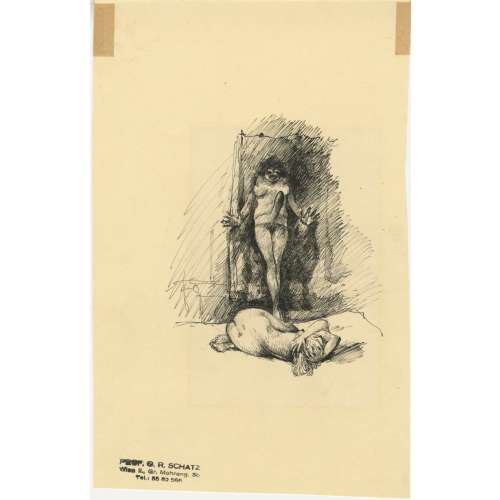 NEWPen and ink drawing on paper, 285 x 184 mm, black ink stamp “PROF. O R SCHATS | Wien II.. Gr. Mohreng, 31 | Tel.: 55 82 566", remnants of mounting hinges to the drawing side; unsigned. Black stamp "Kunst bei Kenst" and blue ballpen ms signed "DKFM E. Kenst" to recto . Artist: Otto Rudolf Schatz (Austrian, 1900 – 1961).
NEWPen and ink drawing on paper, 285 x 184 mm, black ink stamp “PROF. O R SCHATS | Wien II.. Gr. Mohreng, 31 | Tel.: 55 82 566", remnants of mounting hinges to the drawing side; unsigned. Black stamp "Kunst bei Kenst" and blue ballpen ms signed "DKFM E. Kenst" to recto . Artist: Otto Rudolf Schatz (Austrian, 1900 – 1961). -
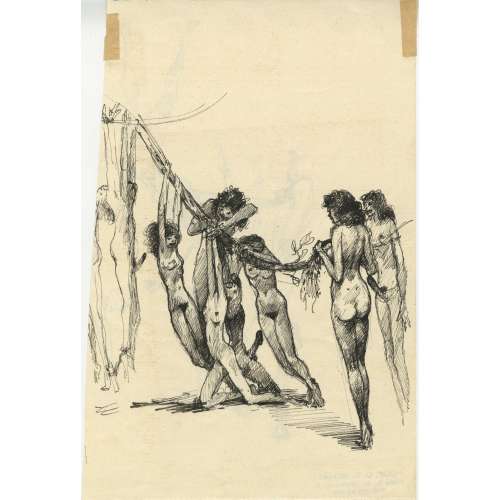 NEWDrawing on both sides upside down; pen and ink on paper, 255 x 170 mm, black ink stamp “PROF. O R SCHATS | Wien II.. Gr. Mohreng, 31 | Tel.: 55 82 566", remnants of mounting hinges; unsigned. Attributed to Otto Rudolf Schatz (Austrian, 1900 – 1961).
NEWDrawing on both sides upside down; pen and ink on paper, 255 x 170 mm, black ink stamp “PROF. O R SCHATS | Wien II.. Gr. Mohreng, 31 | Tel.: 55 82 566", remnants of mounting hinges; unsigned. Attributed to Otto Rudolf Schatz (Austrian, 1900 – 1961). -
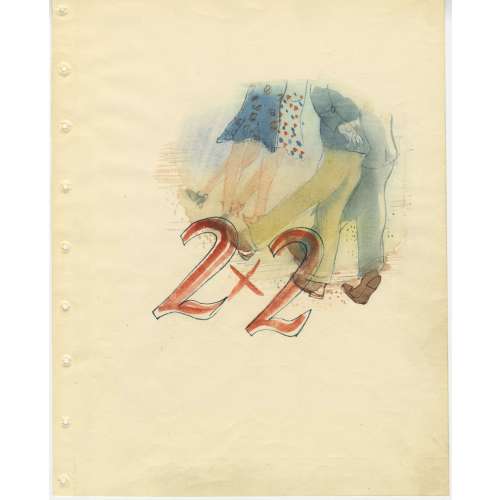 NEWTwo loose sheets, one 295 x 235 mm and another, the title page, 295 x 470 mm, folded in half with the image on one side only, leaves pierced for being bound in an album. Artist: Otto Rudolf Schatz (Austrian, 1900 – 1961).
NEWTwo loose sheets, one 295 x 235 mm and another, the title page, 295 x 470 mm, folded in half with the image on one side only, leaves pierced for being bound in an album. Artist: Otto Rudolf Schatz (Austrian, 1900 – 1961). -
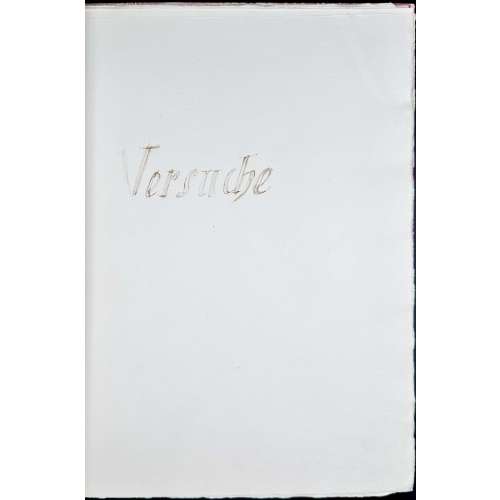 NEWAlbum of 10 watercolour drawings on thick wove paper sheets 315 x 245 mm, incl. title and colophon, plus one blank sheet before the title page, in Japanese stab binding — cardboard covers with stripes and ribbons marbling, sewed with blue thread. Signed and dated on the rearmost sheet. Versuch (German)— trial, experiment, test, attempt. Artist: Otto Rudolf Schatz (Austrian, 1900 – 1961).
NEWAlbum of 10 watercolour drawings on thick wove paper sheets 315 x 245 mm, incl. title and colophon, plus one blank sheet before the title page, in Japanese stab binding — cardboard covers with stripes and ribbons marbling, sewed with blue thread. Signed and dated on the rearmost sheet. Versuch (German)— trial, experiment, test, attempt. Artist: Otto Rudolf Schatz (Austrian, 1900 – 1961). -
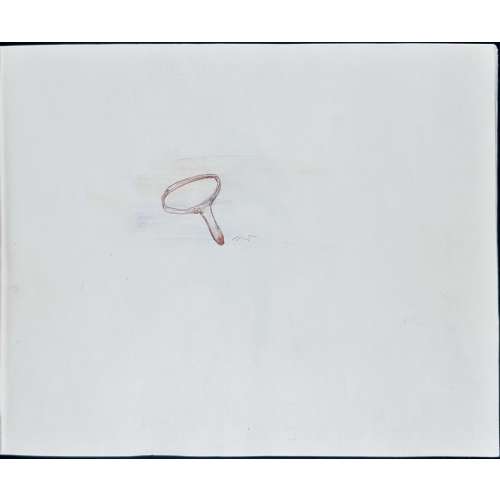 NEWAlbum of 17 watercolour drawings on thick wove paper sheets 265 x 205 mm, incl. title and colophon, in Japanese stab binding — cardboard covers with yellow and grey stripes sewed with pink thread. Signed and dated. The conditional title of the album may be "Girl's Toy". Artist: Otto Rudolf Schatz (Austrian, 1900 – 1961).
NEWAlbum of 17 watercolour drawings on thick wove paper sheets 265 x 205 mm, incl. title and colophon, in Japanese stab binding — cardboard covers with yellow and grey stripes sewed with pink thread. Signed and dated. The conditional title of the album may be "Girl's Toy". Artist: Otto Rudolf Schatz (Austrian, 1900 – 1961). -
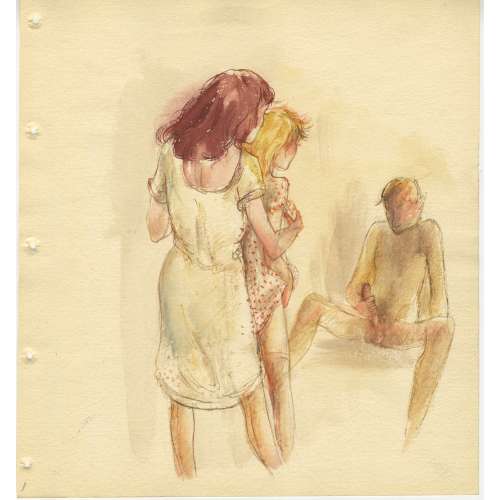 NEWEleven loose sheets, approx. 250 x 230 mm each, numbered in the bottom left corner in pencil (by owner?), with five binding holes in the left margin, traces of passe-partout mounting to verso; no title sheet. It is probably a disbound watercolour album telling the same story as the printed Der Kleine Bruder (see SVE-0581.2024). Artist: Otto Rudolf Schatz (Austrian, 1900 – 1961).
NEWEleven loose sheets, approx. 250 x 230 mm each, numbered in the bottom left corner in pencil (by owner?), with five binding holes in the left margin, traces of passe-partout mounting to verso; no title sheet. It is probably a disbound watercolour album telling the same story as the printed Der Kleine Bruder (see SVE-0581.2024). Artist: Otto Rudolf Schatz (Austrian, 1900 – 1961). -
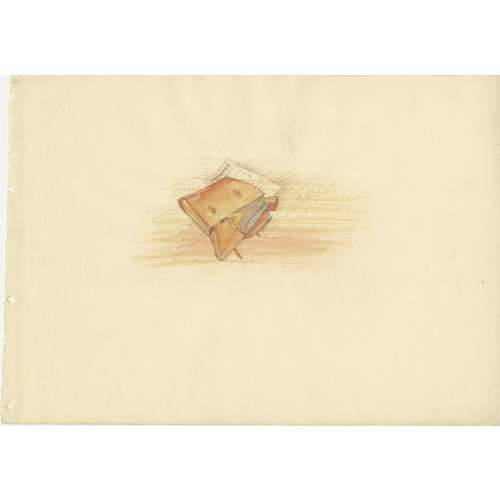 NEWZeugnis (Grade book) – a set of fifteen plates, incl. the title page and the colophon, that tells the story of a schoolgirl whose parents spanked her for not being a good student. Watercolour and ink on 244 x 344 mm cream laid paper with Hahnemühle's watermark (rooster with a shield), signed and dated in manuscript on the last page (colophon) "O. R. SCHATZ | 1954 | X", unbound (disbound), with four binding holes in the left margin of each sheet; no boards. Artist: Otto Rudolf Schatz (Austrian, 1900 – 1961).
NEWZeugnis (Grade book) – a set of fifteen plates, incl. the title page and the colophon, that tells the story of a schoolgirl whose parents spanked her for not being a good student. Watercolour and ink on 244 x 344 mm cream laid paper with Hahnemühle's watermark (rooster with a shield), signed and dated in manuscript on the last page (colophon) "O. R. SCHATZ | 1954 | X", unbound (disbound), with four binding holes in the left margin of each sheet; no boards. Artist: Otto Rudolf Schatz (Austrian, 1900 – 1961). -
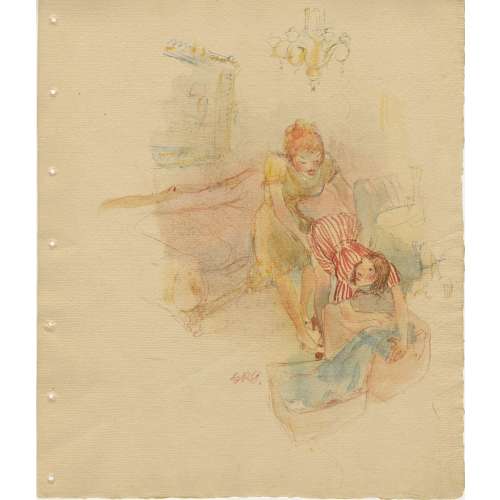 NEWWatercolour, pen and ink on laid paper 313 x 265 mm; each monogrammed "ORS” in manuscript; seven ex-album holes along the left margin. Artist: Otto Rudolf Schatz (Austrian, 1900 – 1961).
NEWWatercolour, pen and ink on laid paper 313 x 265 mm; each monogrammed "ORS” in manuscript; seven ex-album holes along the left margin. Artist: Otto Rudolf Schatz (Austrian, 1900 – 1961). -
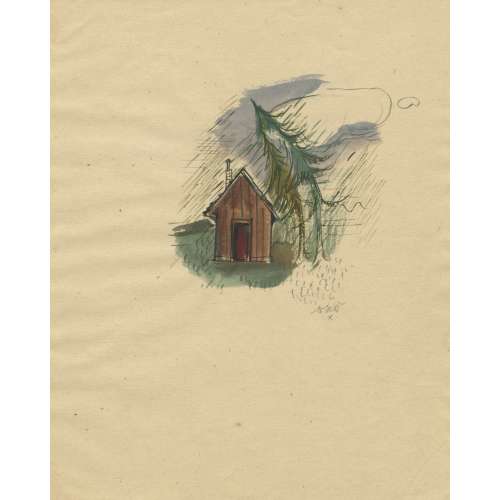 NEWCardboard clamshell box of red buckram over marbled paper 360 x 260 mm, contains 13 drawings (watercolour and pen on paper), wove paper sheets approx. 220 x 190 mm, title page mounted on a blank sheet and monogrammed 'ORS", others in passe-partout 350 x 250 mm, unsigned. Artist: Otto Rudolf Schatz (Austrian, 1900 – 1961).
NEWCardboard clamshell box of red buckram over marbled paper 360 x 260 mm, contains 13 drawings (watercolour and pen on paper), wove paper sheets approx. 220 x 190 mm, title page mounted on a blank sheet and monogrammed 'ORS", others in passe-partout 350 x 250 mm, unsigned. Artist: Otto Rudolf Schatz (Austrian, 1900 – 1961). -
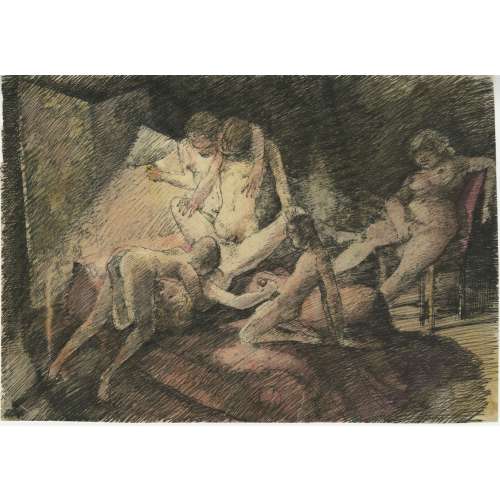 Watercolour, pen and ink on paper, 195 x 282 mm; to verso: black ink stamp “Nachlaß O R SCHATZ" and fuchsia ink stamp ARS EROTICA | Hans-J. Döpp; traces of mounting and repair. Untitled. Artist: Otto Rudolf Schatz (Austrian, 1900 – 1961).
Watercolour, pen and ink on paper, 195 x 282 mm; to verso: black ink stamp “Nachlaß O R SCHATZ" and fuchsia ink stamp ARS EROTICA | Hans-J. Döpp; traces of mounting and repair. Untitled. Artist: Otto Rudolf Schatz (Austrian, 1900 – 1961). -
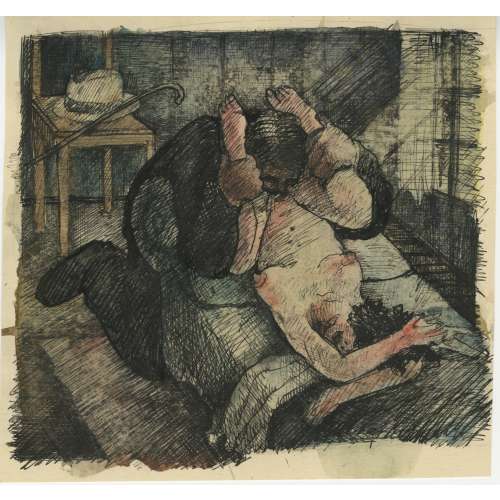 Watercolour, India ink, pen and ink on card stock, 165 x 174 mm; to verso: black ink stamp “Nachlaß O R SCHATZ" and fuchsia ink stamp ARS EROTICA | Hans-J. Döpp; traces of mounting. Untitled. Artist: Otto Rudolf Schatz (Austrian, 1900 – 1961).
Watercolour, India ink, pen and ink on card stock, 165 x 174 mm; to verso: black ink stamp “Nachlaß O R SCHATZ" and fuchsia ink stamp ARS EROTICA | Hans-J. Döpp; traces of mounting. Untitled. Artist: Otto Rudolf Schatz (Austrian, 1900 – 1961). -
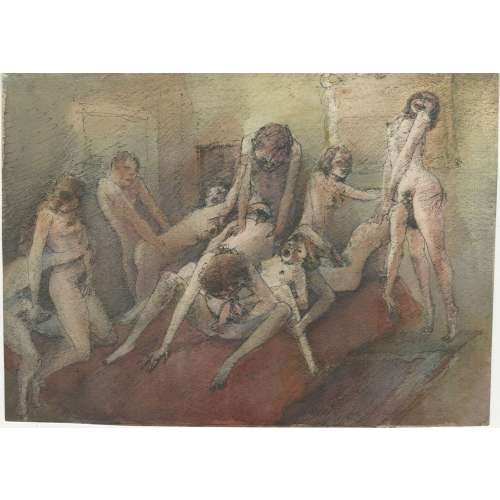 Watercolour, pen and black ink on card stock, 179 x 247 mm; pencil inscription to verso "Otto Rudolf Schatz 3233-03", traces of mounting. Untitled. Artist: Otto Rudolf Schatz (Austrian, 1900 – 1961).
Watercolour, pen and black ink on card stock, 179 x 247 mm; pencil inscription to verso "Otto Rudolf Schatz 3233-03", traces of mounting. Untitled. Artist: Otto Rudolf Schatz (Austrian, 1900 – 1961). -
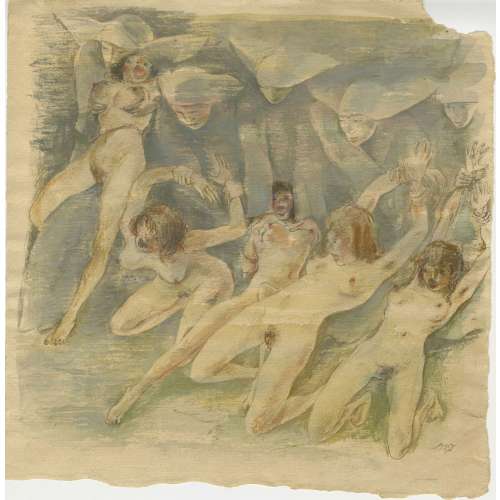 Watercolour, pen and ink wash on thick wove paper, 295 x 298 mm, monogrammed in the bottom right corner "ORSx"; pencil inscription to verso "Um 1950 Otto Rudolf Schatz 3233-03"; two margins cut, traces of mounting on top margin. Untitled. Artist: Otto Rudolf Schatz (Austrian, 1900 – 1961).
Watercolour, pen and ink wash on thick wove paper, 295 x 298 mm, monogrammed in the bottom right corner "ORSx"; pencil inscription to verso "Um 1950 Otto Rudolf Schatz 3233-03"; two margins cut, traces of mounting on top margin. Untitled. Artist: Otto Rudolf Schatz (Austrian, 1900 – 1961). -
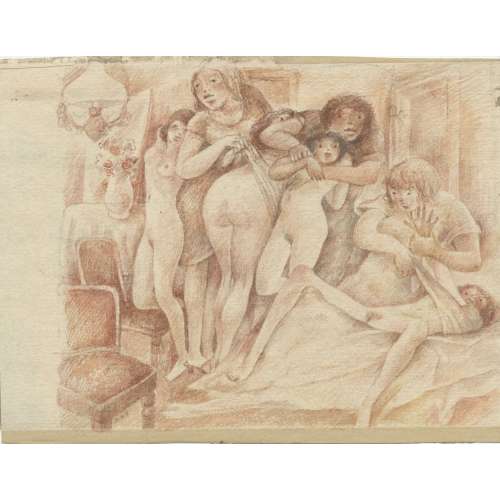 Watercolour, pen and ink on thick wove paper, 177 x 235 mm; to verso: blue ink stamp “Nachlaß O R SCHATZ" and fuchsia ink stamp ARS EROTICA | Hans-J. Döpp; traces of framing along all the margins; traces of framing along the margins; remains of hinges. Artist: Otto Rudolf Schatz (Austrian, 1900 – 1961).
Watercolour, pen and ink on thick wove paper, 177 x 235 mm; to verso: blue ink stamp “Nachlaß O R SCHATZ" and fuchsia ink stamp ARS EROTICA | Hans-J. Döpp; traces of framing along all the margins; traces of framing along the margins; remains of hinges. Artist: Otto Rudolf Schatz (Austrian, 1900 – 1961). -
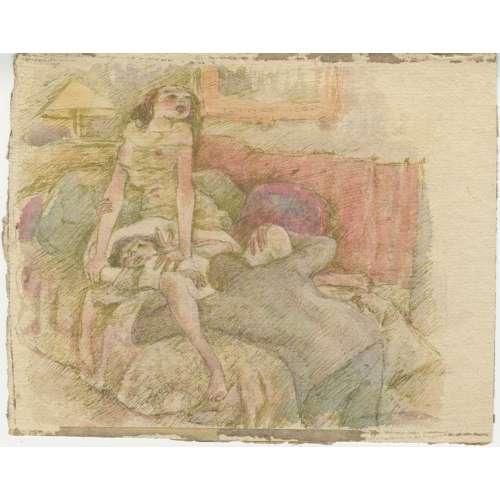 Watercolour, pen and ink on thick wove paper, 180 x 220 mm; to verso: blue ink stamp “PROF O. R. SCHATZ | Wien II, Gr. Mohreng 3b | Tel.: 55 82 566”; fuchsia ink stamp "ARS EROTICA | Hans-J. Döpp"; traces of framing along the margins. Artist: Otto Rudolf Schatz (Austrian, 1900 – 1961).
Watercolour, pen and ink on thick wove paper, 180 x 220 mm; to verso: blue ink stamp “PROF O. R. SCHATZ | Wien II, Gr. Mohreng 3b | Tel.: 55 82 566”; fuchsia ink stamp "ARS EROTICA | Hans-J. Döpp"; traces of framing along the margins. Artist: Otto Rudolf Schatz (Austrian, 1900 – 1961). -
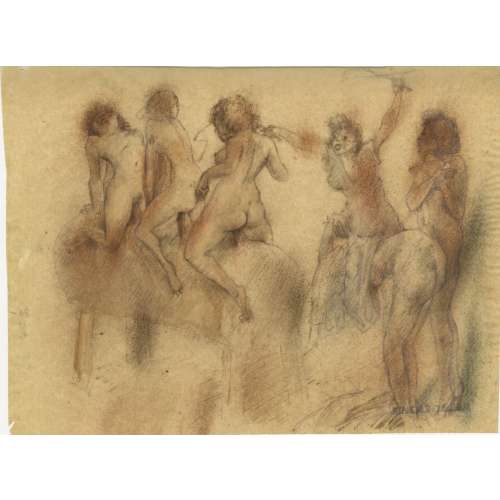 Pencil, pen and ink wash on india paper, 170 x 228 mm, black ink stamp to verso: “Nachlaß O R SCHATS”. Unsigned, attributed to Otto Rudolf Schatz (Austrian, 1900 – 1961).
Pencil, pen and ink wash on india paper, 170 x 228 mm, black ink stamp to verso: “Nachlaß O R SCHATS”. Unsigned, attributed to Otto Rudolf Schatz (Austrian, 1900 – 1961). -
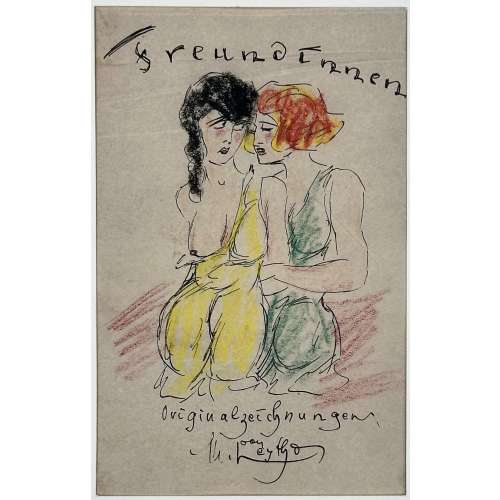 Seven pen and ink and colour crayon drawings on thin wove paper approx. 140 x 100 mm, each attached to a sheet 310 x 240 mm and mounted in a passepartout, placed in an aubergine cardboard folder 310 x 250 mm with a tan vellum spine and paper flaps inside; olive label with double border and gilt lettering to front cover "Dessins" [Drawings]. The first sheet is a title-page lettered in manuscript: Freundinnen | {vignette} | Originalzeichnungen | M. Leytho || [Girlfriends. Original drawings]. Information about the artist at www.honesterotica.com: "Mitja Leytho, almost certainly a pseudonym, is yet another mediocre yet fascinating amateur artist from the Germany of the 1920s about whom we know absolutely nothing beyond the four portfolios which bear the ‘Leytho’ signature". We shall notice that this set of drawings was produced by a talented professional, not an amateur.
Seven pen and ink and colour crayon drawings on thin wove paper approx. 140 x 100 mm, each attached to a sheet 310 x 240 mm and mounted in a passepartout, placed in an aubergine cardboard folder 310 x 250 mm with a tan vellum spine and paper flaps inside; olive label with double border and gilt lettering to front cover "Dessins" [Drawings]. The first sheet is a title-page lettered in manuscript: Freundinnen | {vignette} | Originalzeichnungen | M. Leytho || [Girlfriends. Original drawings]. Information about the artist at www.honesterotica.com: "Mitja Leytho, almost certainly a pseudonym, is yet another mediocre yet fascinating amateur artist from the Germany of the 1920s about whom we know absolutely nothing beyond the four portfolios which bear the ‘Leytho’ signature". We shall notice that this set of drawings was produced by a talented professional, not an amateur. -
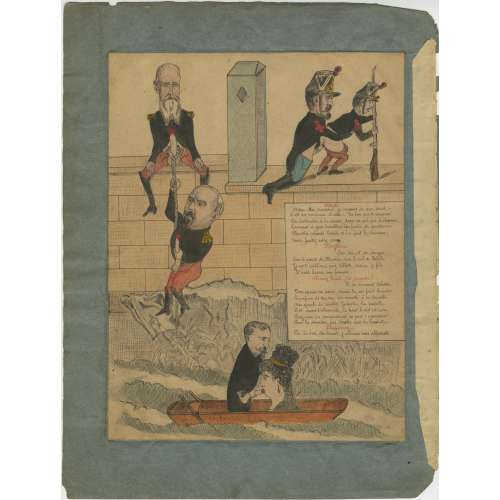 A series of seven political caricatures with indecent content, ink and pigment on paper, bound in a grey-blue folder. Each drawing is pasted to a grey-blue sheet of paper 32 x 24 cm. PLATES: 1) Villette; Bazaine; Alvarez Rull: 250 x 192 mm
A series of seven political caricatures with indecent content, ink and pigment on paper, bound in a grey-blue folder. Each drawing is pasted to a grey-blue sheet of paper 32 x 24 cm. PLATES: 1) Villette; Bazaine; Alvarez Rull: 250 x 192 mm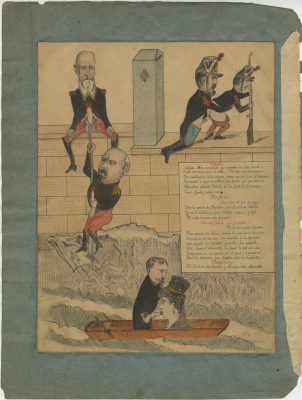
Villette Adieu, cher maréchal, je réponds de mon dard C’est un morceau d’acier… Là bas, sur le rempart, Sa cartouche à la main, dans un cul qui le charme, Lançant à gros bouillons son foutre de gendarme Plantin plante Delille et lui font le Caisson. Bazaine Sur ton vit de dragon Sur le nœud de Plantin, sur le cul de Delille, Je ne t’oublierai pas, Villette, adieu, je file Et je vais baiser ma femme. Alvarez Rull (à Josépha) Il ne saurait tarder, Ton epoux va venir, mais tu me fais bander, Le parfum de ton con me monte à la cervelle, Ma gaule se raidit . Josépha, la nacelle Est dans l’ obscurité, là haut, le ciel est noir, Bazaine en descendant ne peut t’ apercevoir … Pour la dernière fois, torche moi la houlette. Bazaine Eh ! là bas, du canot, j’allume une allumette!
Villette Farewell, dear Marshal, I vouch for my dick. It’s like a steel rod … Over there, on the ramparts, Plantin, his dick in hand, pounds Delisle’s beckoning ass And fills it with his bubbling gendarme’s cum. Bazaine For your dragoon’s dick, For Plantin's prick, for Delisle's ass, I won't forget you, Villette, goodbye, I'm leaving And I'm going to fuck my wife. Alvarez Rull (to Josépha) Hurry up, Your husband is coming, but I got a hard on you, The scent of your cunt penetrates my brain, My rod stiffened. Josépha, the gondola Is in the dark, the sky is black, Bazaine coming down and cannot see you... Give me one last blowjob.Bazaine Hey! Over there, from the canoe, I light a match!
French marshal Achille Bazaine capitulated to Bismarck during the Franco-Prussian war on 27 October 1870. In 1873, he was tried for treason and received a death sentence, later commuted to 20 years' imprisonment. Bazaine was incarcerated in the Fort Royal on Île Sainte-Marguerite, from which he escaped on August 9–10, 1874, with the help of Colonel Villette [Willette], his wife Josefa [Pepita Peña], and her nephew Alvarez Rull. They sailed to Genoa in Italy and from there to London. Plantin and Delisle were prison guards. The story was described in detail during the Trial of Col. Villette and his Accomplices in 1874 and published later in Robert Christophe. La Vie tragique du maréchal Bazaine. — Paris: Vautrain Jacques, 1947.
2) Impératrice Eugénie: 218 x 165 mm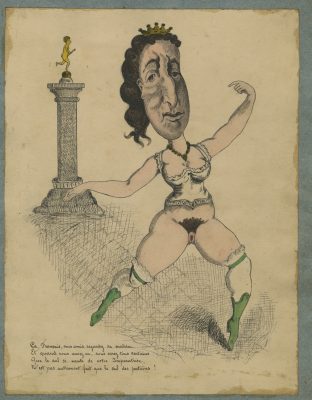
Ça, Français, mes amis, regardez sa matrice, Et quand vous aurez vu, vous serez tous certains Que le cul si vanté de votre Impératrice, N’est pas autrement fait que le cul des putains!
That, French, my friends, look at her cunt, And when you have seen, you will all be certain That the so acclaimed ass of your Empress, Is no different than the ass of whores! 3) Napoléon III: 215 x 168 mm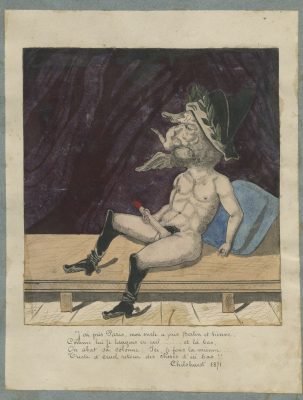
J’ai pris Paris, mon oncle a pris Berlin et Vienne. Comme lui je languis en exil …… et là bas, On abat sa colonne; Ici, je fous la mienne…. Triste et cruel retour des choses d’ici bas!! Chilshurst 1871. [i.e. Chislehurst]
I took Paris, my uncle took Berlin and Vienna. Like him, I, too, languish in exile. His column there was demolished; I’m jerking mine off here…. Cruel and sorrowful deeds!! 4) La confession: 216 x 168 mm (Georges Darboy?)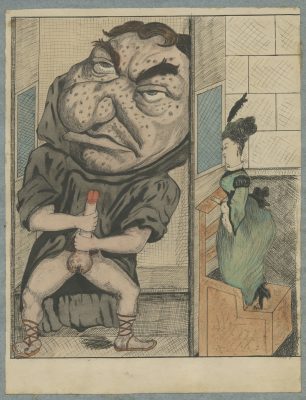 5) Napoléon III et Thérèsa (chanteuse Désirée Emma Valladon): 216 x 176 mm
5) Napoléon III et Thérèsa (chanteuse Désirée Emma Valladon): 216 x 176 mm
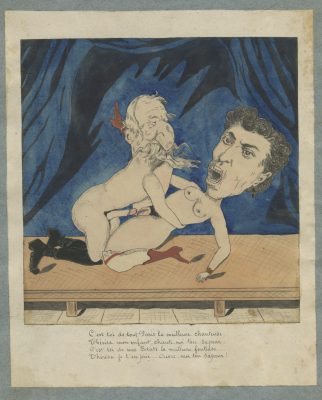
C’est toi de tout Paris la meilleure chanteuse, Thérèsa mon enfant, chante-moi ton sapeur. C’est toi de mes Etats la meilleure fonteuse.. Thérèsa je t’en prie … Ouvre-moi ton sapeur!
You, the best singer in all of Paris, Teresa, my child, sing for me where to insert. You are the best padding in my entire country… Teresa, please... Open your slit for me! 6) Thiers: 219 x 168 mm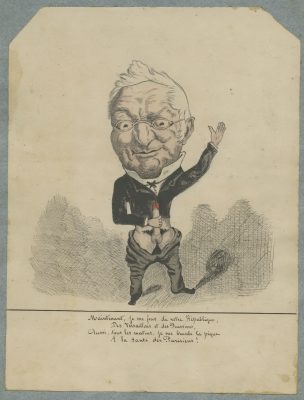
Maintenant, je me fous de votre République, Des Versaillais et des Prussiens, Aussi, tous les matins, je me branle la pique A la santé des Parisiens!
Yes, I don’t care about your Republic now, About Versailles and the Prussians, And every morning I jerk off For the health of Parisians! 7) Émile Ollivier/Rochefort/Jules Favre/Gambetta : 212 x 168 mm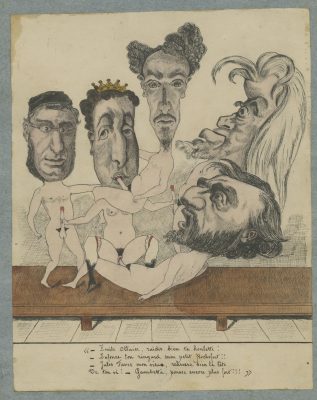
« — Emile Ollivier, raidis bien la houlette! — Enfonce ton ringard mon petit Rochefort!! — Jules Favre mon vieux, redresse bien la tête De ton vi! — Gambetta, pousse encore plus fort!!! »
Emile Ollivier, tighten your dick! - Stick in your poker, my little Rochefort!! - Jules Favre, old man, straighten your dickhead Damn it! – Gambetta, push even harder!!!Characters: Bazaine, François Achille (French, 1811 – 1888) Darboy, Georges (French, 1813 – 1871) Favre, Jules (French, 1809 – 1880) Gambetta, Léon (French, 1838 – 1882) Montijo, Eugénie de (Spanish-French, 1826 – 1920) Napoleon III [Bonaparte, Charles-Louis Napoléon] (French, 1808 – 1873) Ollivier, Émile (French, 1825 – 1913) Peña Azcárate, Josefa [Peña, Pepita] (Mexican-French, 1847 – 1900); Alvarez Rull – nephew of Josefa Peña Azcárate. Rochefort, Henri (French, 1831 – 1913) Thérésa [Valladon, Désirée Emma] (French, 1836 – 1913) Thiers, Adolphe (French, 1797 – 1877)
-
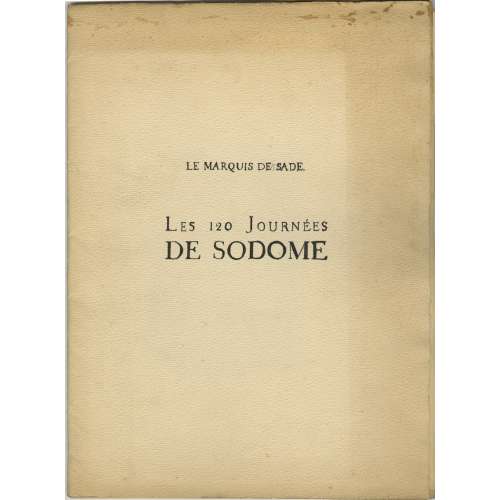 A set of sixteen pen and ink wash drawings on wove paper by an anonymous artist after lithographs by André Collot, who illustrated the 1935 edition of Les 120 journées de Sodome, ou l’école du libertinage, by the Marquis de Sade, based on the original autograph manuscript by Maurice Heine. The set is housed in a rough texture paper folder with an ink manuscript to the front: LE MARQUIS DE SADE. | Les 120 journées | DE SODOME || Size: 340 x 250 mm (folder); 335 x 252 (sheet); approx. 160 x 110 (image). Contributors: Donatien Alphonse François, Marquis de Sade (French, 1740 – 1814) – author. Maurice Heine (French, 1884 – 1940) – publisher of the original Les 120 journées. André Collot (French, 1897-1976) – artist of the original illustrations for the 1935 edition. This set was produced by an anonymous artist from the bohemian Montmartre, Montparnasse, or the School of Fine Arts, close to the booksellers', by demand of an excentric bibliophile, at about the same time. Collot's illustrations can be found at www.honesterotica.com.
A set of sixteen pen and ink wash drawings on wove paper by an anonymous artist after lithographs by André Collot, who illustrated the 1935 edition of Les 120 journées de Sodome, ou l’école du libertinage, by the Marquis de Sade, based on the original autograph manuscript by Maurice Heine. The set is housed in a rough texture paper folder with an ink manuscript to the front: LE MARQUIS DE SADE. | Les 120 journées | DE SODOME || Size: 340 x 250 mm (folder); 335 x 252 (sheet); approx. 160 x 110 (image). Contributors: Donatien Alphonse François, Marquis de Sade (French, 1740 – 1814) – author. Maurice Heine (French, 1884 – 1940) – publisher of the original Les 120 journées. André Collot (French, 1897-1976) – artist of the original illustrations for the 1935 edition. This set was produced by an anonymous artist from the bohemian Montmartre, Montparnasse, or the School of Fine Arts, close to the booksellers', by demand of an excentric bibliophile, at about the same time. Collot's illustrations can be found at www.honesterotica.com. -
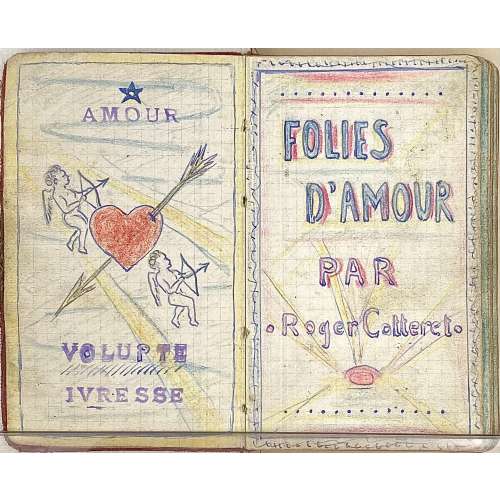 Lavishly illustrated manuscript bound in brown cloth with a red cloth border, 12.3 x 7.5 x 1.6 cm, green marbled endpapers with the inscription “Mein | Kampf” to free leaf, front pastedown with a pocket; written with blue ink and drawn with colour crayons on checkered notepaper with rounded corners, unpaginated, 104 leaves total. Frontispiece: ☆ | AMOUR | {two cupids and a heart pierced with an arrow, sunbeams} | VOLUPTE | IVRESSE || Title-page: FOLIES | D'AMOUR | PAR | • Roger Cotteret • | {raising sun and sunbeams} | row of dots || A copy of the whole manuscript is presented here.
Lavishly illustrated manuscript bound in brown cloth with a red cloth border, 12.3 x 7.5 x 1.6 cm, green marbled endpapers with the inscription “Mein | Kampf” to free leaf, front pastedown with a pocket; written with blue ink and drawn with colour crayons on checkered notepaper with rounded corners, unpaginated, 104 leaves total. Frontispiece: ☆ | AMOUR | {two cupids and a heart pierced with an arrow, sunbeams} | VOLUPTE | IVRESSE || Title-page: FOLIES | D'AMOUR | PAR | • Roger Cotteret • | {raising sun and sunbeams} | row of dots || A copy of the whole manuscript is presented here.


